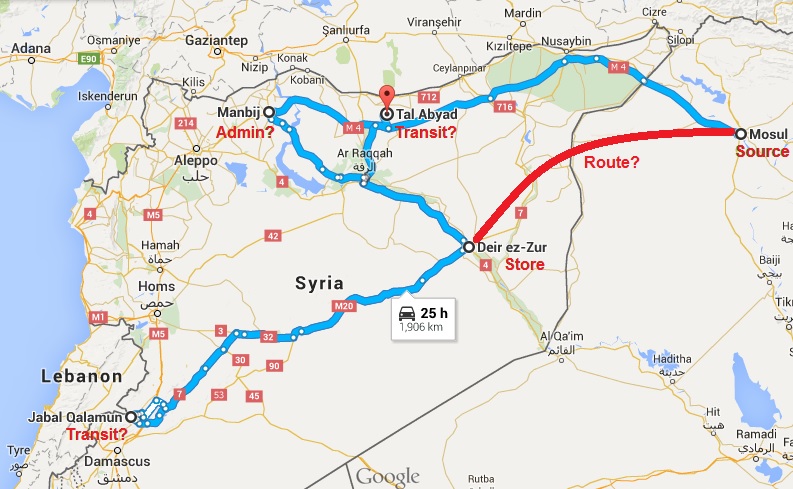As Iraqia TV correspondent Amir Musawy scooped and SWR reporter Esther Saoub @esaoub translated, the United States has given ‘#antiquities to #Iraq, that [were] seized with #ISIS commander Abu Sayyaf in #Syria’; it is the ‘first material proof that #ISIS is engaged in #antiquity trade’. And it demonstrates several features of the trade all at once.
There have been a lot of updates, which are here, but I consider whether this was Abu Sayyaf’s stash and where it might have been assembled more fully (or more coherently) in an update-summarising follow-up post.
In a further follow-up, I’ve reassessed the balance of antiquities and forgeries. I believe that most of Abu Sayyaf’s stash comprised ancient coins.
[I’m working on a huge update based on the U.S. State Department Cultural Heritage Center’s summary and photo gallery of the ISIL leader’s loot.]
The manager of oil and gas sales for the Islamic State, Sayyaf was killed in an attempt to capture him by U.S. Delta Force commandos, near the oil fields south-east of Deir ez-Zor, on the 16th of May 2015. Two months later, the details are finally emerging via Amir Musawy.
Terrorist stockpiling of antiquities from Iraq in Syria
70 or 400 or 500 [or 700 or 750]?
Yesterday, Südwestrundfunk (SWR) reported that the Islamic State leader’s stash comprised more than seventy ‘carefully-wrapped/carefully-boxed antiquities and Islamic artworks…, amongst them apparently pieces from the museum in northern Iraqi Mosul that was plundered and destroyed by IS [sorgfältig verpackte Antiken und islamische Kunstwerke…, darunter offenbar Stücke aus dem zuvor vom IS geplünderten und zerstörten Museum im nordirakischen Mossul]’, as well as ‘antiquities from Syria itself [Antiken aus Syrien selbst]’.
Curiously, today, [the Washington Post stated that Iraq had regained ‘more than 400 ancient artifacts’ through that raid, while] the Associated Press stated that the National Museum of Iraq in Baghdad had regained ‘nearly 500 artifacts‘, “many” of which had been ‘stolen during the 2003 U.S.-led invasion’, some of which had been looted over the course of the following years. Eventually, somehow, thereafter, they all ended up in ‘the hands of Islamic State extremists and were smuggled out of Iraq into Syria’.
[Update (16th July 2015): It is unclear how many there are or when they will be returned, but any Syrian objects will be returned to Syria ‘soon [demnächst]’.]
Were first 70 presented, then another 430? Did the 70 count as parts of a whole (beads of a necklace, coins of a hoard, etc.) things that the 500 counted separately? Did the 500 include antiquities that had been recovered in other operations?
[Update (15th July 2015): Esther Saoub agrees that the difference in numbers may be a matter of how you count: ‘the fact that there were many coins and small pieces among the artefacts might be a reason for the differing numbers’. Singly-labelled bags of multiple objects (which are standard in collection management) can be seen at 00h01m41s and 00h01m45s in Musawy’s video.]
[Update (17th July 2015): the Embassy of the United States in Iraq had said that there were ‘700 objects and fragments’. I found that when I followed a link from the Cultural Heritage Center of the U.S. Department of State, which had said that there were 750 “cultural heritage objects and fragments”, which Paul Barford had found.]
[Update (16th July 2015): As the head of excavations in Lebanon, Assaad Seif, told the BBC in a separate discussion, their law enforcement agencies had seized most illicit cultural goods from Syria from Islamic State territory, and they had seized hundreds of antiquities but thousands of forgeries. Is it possible that this was one shipment of material, which included a few genuine articles among a lot of fakes, hence the poor range of poor imitations? Considering the metal-smelting crucible that Paul Barford noticed, is it even possible that Sayyaf’s hideout was a forgery workshop? The Bible/biblical manuscript may be significant.]
Criminal stockpiling, terrorist stockpiling
Regardless of exactly how many of those antiquities had been looted from the National Museum in Iraq, it is significant that any long-ago-looted antiquities from Baghdad Museum were acquired, smuggled and stored in an Islamic State paramilitary base in Syria alongside recently-looted antiquities from Mosul Museum.
Were they sold to the Islamic State by a stockpiling dealer who had acquired them and stashed them for years or by a powerful collector who finally found himself on the wrong side of power? Were they “expropriated” (stolen) from the illicit handler by the Islamic State?
“Mesopotamian” antiquities and Egyptian forgeries
Reuters listed finds such as ‘ancient cylindrical stamps, pottery, metallic bracelets and other jewellery, and glass shards from what appeared to be a coloured vase’ [which may be seen in Vivian Salama’s photo below] as well as ‘early Islamic coins‘, while the Associated Press noted ‘royal seals used by kings in the ancient Assyrian city of Nimrud‘. Paul Barford noted something else – a ‘fake Nefertiti head’. How many other objects are fakes?
[Update (15th July 2015): I was confused by images in Reuters’ original article that were described as “recovered artefacts are seen at the National Museum of Iraq in Baghdad, Iraq July 8, 2015”, which had been photographed by Khalid al-Mousily, but I included them because I thought that the difference in the reported numbers might have been a product of the inclusion of previously-seized antiquities. They were indeed photos from a previous report (which Donna Yates found), which had been re-uploaded by mistake. Thaier al-Sudani’s photos are the ones from this event.]

Photos that had been taken by Khalid al-Mousily on the 8th of July 2015 were accidentally re-uploaded by Reuters on the 15th of July 2015
[Update (16th July 2015): As the Washington Post’s Loveday Morris has noted, object codes from the National Museum of Iraq are visible at least a few of the artefacts – such as the seals – which may explain how the origins of otherwise difficult-to-place objects like worked stones were conclusively traced back to Iraq. (Paul Barford has pointed out that Amir Musawy‘s video shows sheets that collate old museum labels.) However, considering the presence of fakes, the codes themselves will need to be checked to ensure that they were not forged to falsely authenticate the objects.]
Iconoclasm, Mammon and very organised crime
Since some of the antiquities were looted from Mosul Museum, it appears that the Islamic State did loot the museum before it recorded the propaganda video of iconoclasm, and is using its ethnic/religious cleansing as a cover for its financing mechanisms. (I’m not denying that it is ideologically committed to cultural destruction, but it is denying that it is engaged in cultural racketeering.) Regardless of the course of events at the museum, these antiquities had evidently been stored for sale rather than destruction.
It also demonstrates that the Islamic State’s antiquities operations are internally complex, as not only Syrian antiquities but also Iraqi antiquities were stashed with a manager of other illicit commodities in Syria. And that stash was in a different section of its territory in Syria from its antiquities administration (Diwan al-Rikaz) in Manbij, which apparently ‘manages loot[ing] and sales‘ – though it has local offices elsewhere too, including at (one of) the source(s) in Mosul.
The evidence is not merely complex but confusing. Had the antiquities from Baghdad been stashed in Mosul? Were the antiquities smuggled from Mosul (and elsewhere, then assembled) and administered in Manbij, then trafficked to Deir ez-Zor, in order to be trafficked north to Tal Abyad and smuggled into Turkey or trafficked west to Qalamoun and smuggled into Lebanon? Were the antiquities destined to be smuggled onto the market by another route? Had the antiquities been smuggled directly from Mosul to Deir ez-Zor?
Update (16th July 2015): A paper trail?
Loveday Morris also relayed that “receipts” alongside objects ‘documented illicit sales dating to the 1980s, suggesting that if they were Abu Sayyaf’s, he may have been in the smuggling game for decades’. If they are genuine, it will be grimly amusing that traffickers in Deir ez-Zor keep better records than dealers in London. But would a mobile terrorist mastermind really carry his thirty-year-old sales receipts around with him, especially when his potential buyers show so little interest in seeing them, let alone acquiring them along with the objects?
Aside
Perhaps someone could suggest to U.S. Ambassador Stuart Jones that he’s laying it on a bit thick by informing the Iraqis, ‘Daesh is stealing your antiquities, and we are giving them back to you’?
Update (16th July 2015): laying it on thick indeed – too poor to be propaganda?
Portable Antiquity Collecting and Heritage Issues’ Paul Barford has done a sterling job of picking out copies, fakes and freaks, from the plaques to the miniature Nefertiti bust to the metal foundry’s smelting crucible.
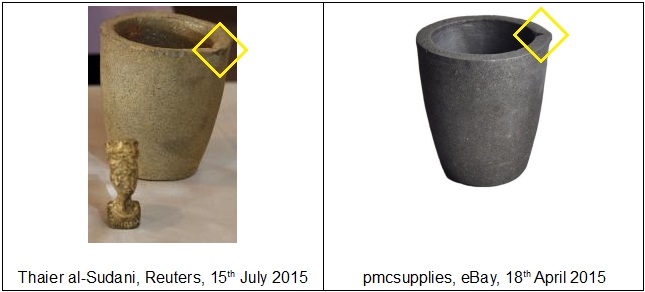
A PACHI-inspired comparison of an object photographed by Thaier al-Sudani, Reuters, 15th July 2015 with a crucible auctioned by pmcsupplies, eBay, 18th April 2015
There are so many holes in the story and loose ends that it is only natural to be suspicious. However, I think that – if it were a U.S. or Iraqi propaganda exercise (beyond PR) – the evidence would have been less rubbish.
There would have been more of the more notoriously sellable “Mesopotamian” (Iraqi) objects. There would have been fewer fragments that are the archaeological equivalent of something only a mother could love. There would have been a fairly complete glazed pot instead of a fragmentary one. There would not have been a fake Nefertiti…
Is this a cache from a forgery workshop in northern Iraq?
Loveday Morris was told that a ‘leather manuscript, written in ancient Aramaic‘, had been ‘seized by US forces during the Abu Sayyaf raid in Syria’ as well. ‘An official at the National Museum of Iraq in Baghdad said Wednesday that it was about 500 years old but has not yet been properly dated.’ I think this may be a particularly instructive find.

‘This leather manuscript, written in ancient Aramaic, was seized by US forces during the Abu Sayyaf raid in Syria’
(Loveday Morris, Twitter, 15th July 2015)
It may help to compare it with a Syriac bible that was probably stolen from south-eastern Turkey and smuggled into Cyprus in 2009, which Byzantinologist Charlotte Roueche and Syriac linguist J. F. Coakley thought might be genuine(ly 500 years old, not reportedly 2,000 years old), Biblical scholar James Davila thought might be modern, Aramaic translator Steve Caruso thought was ‘probably either a work no earlier than the 15th century, or a modern forgery‘, and Aramaic and Syriac lecturer David G. K. Taylor judged to be ‘one of a large number of fake Syriac manuscripts currently being produced in northern Iraq and southern Turkey’.

‘Ancient’ Syriac bible found in Cyprus
(c) Sarah Ktisti and Simon Bahceli, Reuters, 6th February 2009

‘Ancient’ Syriac bible found in Cyprus
(c) China Daily, 7th February 2009
The book in Syria has a fairly uniform, deep and wide darkening along the vertical edge of the page, which the book in Cyprus does not. The book in Syria appears to have something like a bullet hole of a cigarette burn. And the “Syrian” book’s painting of a figure with a raised right hand appears to have been reduced to a ghostly stain on the page, whereas the “Cypriot” book’s artwork is still clear.
Obviously, some – perhaps most – of these objects are genuine antiquities, and some of them can even be traced back to individual episodes of theft. But some of these objects seem to be forgeries. And one of the notorious forgery industries is in the same place as one of the confirmed sites of theft. Could they have been assembled and shipped from Mosul?
Photos and video by Amir Musawy, Südwestrundfunk, Thaier al-Sudani, Reuters and Vivian Salama
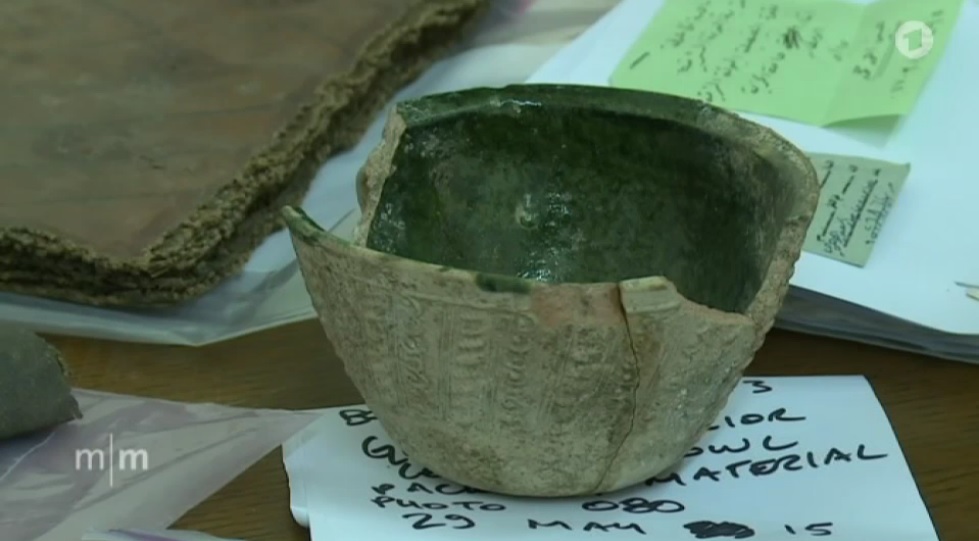
Kultur kommt zürück
(c) Amir Musawy, Mittagsmagazin, Das Erste, 15. Juli 2015 (00h01m23s)

Kultur kommt zürück
(c) Amir Musawy, Mittagsmagazin, Das Erste, 15. Juli 2015 (00h01m41s)
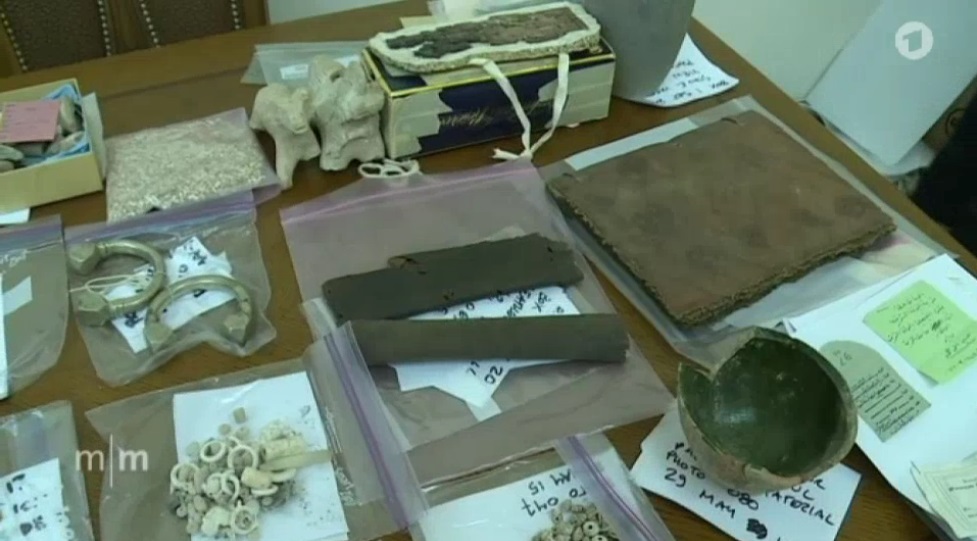
Kultur kommt zürück
(c) Amir Musawy, Mittagsmagazin, Das Erste, 15. Juli 2015 (00h01m45s)
!['Die geretteten Kunstwerke sind jetzt in einem Bagdader Museum zu sehen [The rescued art can now be seen in a Baghdad museum]' (c) SWR, 14. Juli 2015](https://conflictantiquities.files.wordpress.com/2015/07/swr-2015-usa-iraq-syria-illicit-antiquities-trade-150714.jpg?w=1024&h=576)
‘Die geretteten Kunstwerke sind jetzt in einem Bagdader Museum zu sehen [The rescued art can now be seen in a Baghdad museum]’
(c) SWR, 14. Juli 2015

Recovered artifacts are seen at the National Museum of Iraq in Baghdad July 15, 2015
(c) Thaier al-Sudani, Reuters, 15th July 2015 a
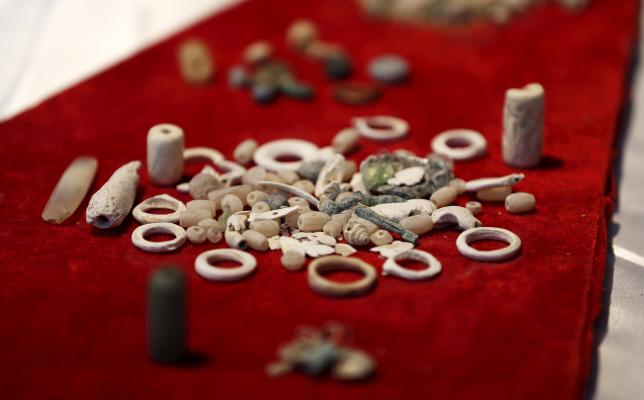
Recovered artifacts are seen at the National Museum of Iraq in Baghdad July 15, 2015
(c) Thaier al-Sudani, Reuters, 15th July 2015 b

Recovered artifacts are seen at the National Museum of Iraq in Baghdad July 15, 2015
(c) Thaier al-Sudani, Reuters, 15th July 2015 c
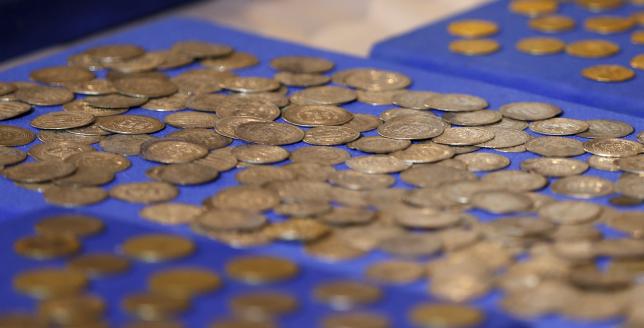
Recovered coins are seen at the National Museum of Iraq in Baghdad July 15, 2015
(c) Thaier al-Sudani, Reuters, 15th July 2015 d
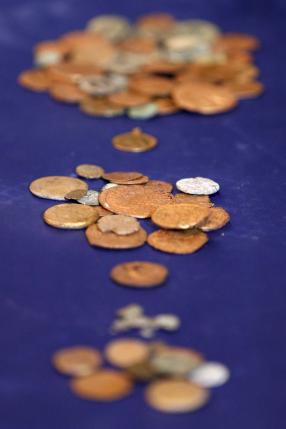
Recovered coins are seen at the National Museum of Iraq in Baghdad July 15, 2015
(c) Thaier al-Sudani, Reuters, 15th July 2015 e
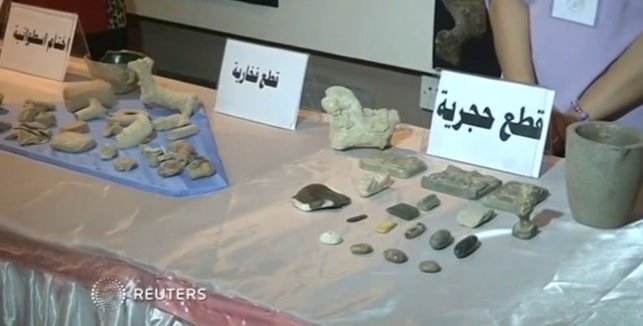
U.S. delivers Iraqi antiquities seized in raid on Islamic State
(c) Reuters, 15th July 2015 (00h00m01s)

U.S. delivers Iraqi antiquities seized in raid on Islamic State
(c) Reuters, 15th July 2015 (00h00m05s)

U.S. delivers Iraqi antiquities seized in raid on Islamic State
(c) Reuters, 15th July 2015 (00h00m10s)
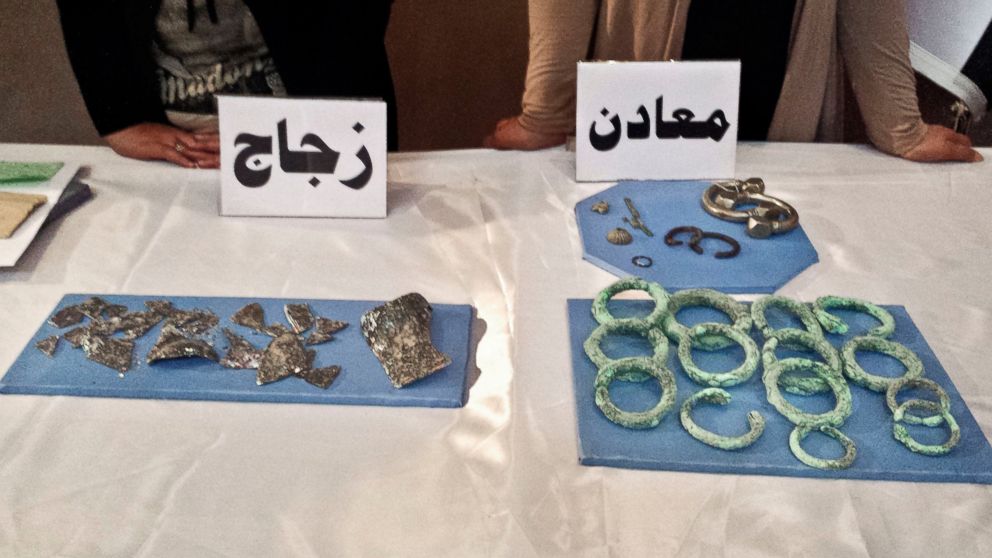
Recovered antiquities are displayed at the Iraqi National Museum in Baghdad, Iraq, Wednesday, July 15, 2015. Nearly 500 artifacts recovered by U.S. Army commandos during a recent raid in Syria targeting the Islamic State group were displayed at the Baghdad National Museum Wednesday after being returned to Iraq.
(c) Vivian Salama, the Associated Press (AP), 15th July 2015
Ignore these photos by Khalid al-Mousily, they were incorrectly published then replaced by Reuters
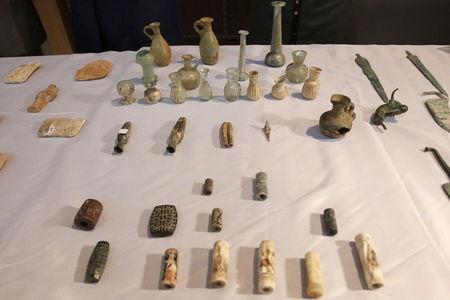
Recovered artefacts are seen at the National Museum of Iraq in Baghdad, Iraq July 8, 2015.
(c) Khalid al-Mousily, Reuters, 15th July 2015 a
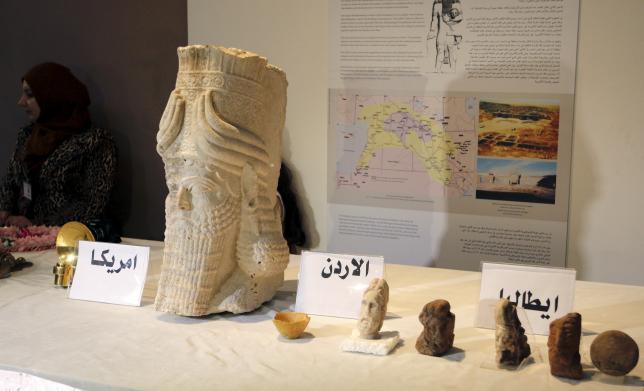
Recovered artefacts are seen at the National Museum of Iraq in Baghdad, Iraq July 8, 2015
(c) Khalid al-Mousily, Reuters, 15th July 2015 b
